Looking after your injured knee
There are many different causes of knee pain, this page provides advice which is relevant to your problem. Please note that some patients will be provided with a knee splint. Specific advice will be provided which the clinician will discuss with you. Please ask if you need further information.
General advice
During the first 5 days, pain relief should be taken – your pharmacist will be able to advice you.
It is also recommended that you follow the advice below:
Apply an ice pack wrapped in a damp towel for 10 minutes. Do not apply ice directly to skin as it can burn. Re-apply every 2 hours for the first 2 to 3 days. If the area becomes very painful, numb or tingles, remove the ice pack immediately. Do not reapply the icepack until the feeling in your skin has returned to normal.
If your knee pain is as a result of an injury, it is important you keep the knee moving. Performing the following exercises will help to prevent stiffness and weakness developing.
Start by sitting upright on a firm surface with your back supported and legs straight. You should be warm and comfortable.
Exercise 1
Hamstring stretch
Pull your foot up at the ankle so that your toes point up to the ceiling.
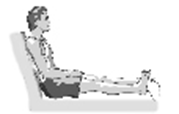
Tense your thigh muscle and if you push your thigh down you work your hamstring, at the back of your leg rather than your quadriceps at the front of your thigh.
Keep tensing your thigh while you count to 5. Repeat this 10 times.
Exercise 2
Heel lift
Place a rolled-up towel underneath your knee.
Press your knee down and lift your heel up until your leg is straight.
Hold your leg straight for a count of 5 then lower your heel gently.
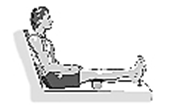
You can make your thigh muscles work harder by placing a weight over your ankle, and increasing the weight progressively.
Remove the towel from underneath the knee and bend the knee as far as it will comfortably go.
If you can reach, gently hug the knee towards your chest. Then straighten your leg.
Repeat this 10 times.
Exercise 3
Leg stretch
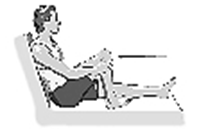
Sit on the floor with your legs stretched out in front.
Keeping your foot to the floor, slowly bend one knee until you feel it being comfortably stretched. Hold for 5 seconds.
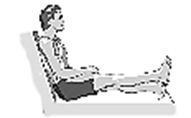
Straighten your leg as far as you can and hold for 5 seconds. Repeat 10 times on each leg.
Exercise 4
Straight-leg raise (sitting)
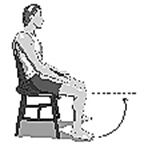
Sit well back in the chair with good posture.
Straighten and raise one leg.
Hold for a slow count to 10 then slowly lower your leg.
Repeat this at least 10 times with each leg.
If you can do this easily, try it with light weights on your ankles and with your toes pointing towards you. This could be done every time you sit down.
Any X-rays taken will be reviewed by a specialist doctor. If there is any concern that there may be a more serious injury, you will be contacted.
Contact information
For further information about managing your injury, please contact:
Physiotherapy
Website: www.gloshospitals.nhs.uk/our-services/services-we-offer/physiotherapy/how-can-i-see-physiotherapist/
NHS 111
Tel: 111